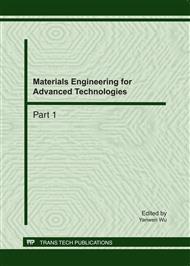p.117
p.120
p.126
p.132
p.137
p.142
p.148
p.153
p.159
Effect of La2O3 on the Electrical Properties of WO3-Based Varistor Ceramics
Abstract:
The nonlinear electrical behavior and dielectric properties of WO3-based ceramics with various La2O3 contents have been investigated. Breakdown voltages Eb of WO3 doped with La2O3 are lower than that of undoped WO3, indicating that the dopant can reduce the breakdown voltage. The dielectric constant of doped samples is higher than that of undoped samples, and the high dielectric constant makes them suitable as capacitor-varistor materials. The theory defects in the crystal lattice was introduced to explain the nonlinear electricial behavior of the La2O3-doped WO3 ceramics. In view of these electrical characteristics, the WO3 ceramic doped with La2O3 is a viable candidate for capacitor-varistor functional devices.
Info:
Periodical:
Pages:
137-141
Citation:
Online since:
June 2011
Authors:
Keywords:
Price:
Сopyright:
© 2011 Trans Tech Publications Ltd. All Rights Reserved
Share:
Citation:


